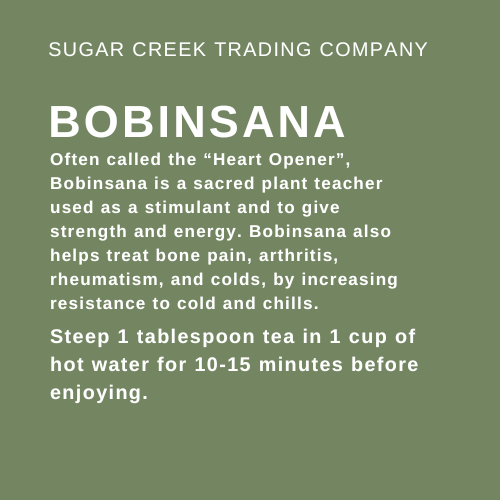Sugar Creek Trading Company
Bobinsana Aerial parts
Bobinsana Aerial parts
Impossibile caricare la disponibilità di ritiro
Calliandra angustifolia
Bobinsana is a sacred plant teacher and is used by shamans for its spiritual
qualities. We are particularly interested in working with Bobinsana for its
gentle heart-opening qualities and its ability to teach us Self-Love. In the Amazon, the Indians of the Rio Pastaza consider bobinsana to be a stimulant. They prepare a decoction of the roots to take for strength and energy.
The Shipibo-Conibo Indians in the Ucayali area of Peru call the tree semein and prepare a bark tincture for rheumatism, arthritis, colds, uterine disorders, and edema (or water retention). The indigenous people and tribes in the Madre de Dios region of the Peruvian Amazon prepare a bark tincture (with aguardiente) for bone pain, arthritis, rheumatism, and colds. They also grate the bark into baths to increase resistance to sickness and to resist the cold and chills.
Bobinsana is also used by the Indians as an adjunctive ingredient in various ayahuasca recipes in the Amazon. While bobinsana is not itself a psychoactive, it is considered a “plant teacher” and is sometimes added to ceremonies to help the shamans connect to and learn from the plants on a spiritual level.
In Peruvian herbal medicine systems a decoction of the bark is prepared and it is considered to be anti-rheumatic, contraceptive, tonic, stimulant, and depurative. A bark decoction is also used for dyspnea (shortness of breath). A decoction of the roots is recommended for uterine cancer and as a depurative (blood cleanser) as well. A decoction of the entire plant (leaves, stem, twigs, flowers) is prepared as a decoction as a general energizing tonic.
This information is gathered directly from:
https://rain-tree.com/bobinsana.htm
CALLIANDRA ANGUSTIFOLIA
The Amazonian Heart Medicine—A Bark of Circulatory Strength, Healing, and Spiritual Renewal
BOTANICAL IDENTIFICATION
Scientific Name: Calliandra angustifolia Benth.
Common Names: Bobinsana, Balata, Bushiglla, Bobinzana, Bubinzana
Family: Fabaceae
Calliandra angustifolia is a small tree or shrub reaching 4–6 meters in height, with compound pinnate leaves and bright pink, powder-puff-like flowers composed of fine stamens. The bark is reddish-brown, while seed pods are flat, brown, and contain several seeds.
It is native to the Amazon Basin, thriving along riverbanks and seasonally flooded areas in Peru, Brazil, Ecuador, and Colombia.
CULTURAL AND HISTORICAL USE
Bobinsana is highly valued by Indigenous Amazonian groups such as the Shipibo-Conibo and Asháninka for its heart-opening, circulatory, and spiritual properties. The bark and leaves are prepared as decoctions or tinctures for rheumatism, joint pain, and blood purification.
In traditional shamanic practices, bobinsana is used in "dieta" rituals for emotional cleansing and to strengthen connection to the spirit world. It is considered a plant teacher, supporting emotional healing and dream clarity.
Colonial and modern herbalists have adopted its use for cardiovascular tonics and inflammation relief.
KEY BIOACTIVE COMPOUNDS AND BENEFITS
| Compound | Role in Plant | Human Benefits | Regional Variation |
|---|---|---|---|
| Tannins | Astringent compounds | Anti-inflammatory, tissue repair | Higher in mature bark |
| Saponins | Plant defense compounds | Circulatory support, immune modulation | Abundant in fresh bark |
| Flavonoids (quercetin) | Antioxidant pigments | Vascular protection, anti-inflammatory | Elevated in wild stands |
| Alkaloids (trace levels) | Nervous system modulation | Mild mood enhancement | Vary with habitat |
| Polyphenols | Secondary metabolites | Cardioprotective and detoxifying | Highest in older roots |
The synergy of tannins and flavonoids provides anti-inflammatory and vascular-stabilizing effects, while saponins enhance circulation.
HOW IT WORKS IN THE BODY
Tannins tighten and strengthen connective tissues, aiding recovery from inflammation and joint pain.
Flavonoids act as antioxidants, reducing oxidative stress in blood vessels and improving circulation.
Saponins support cardiovascular tone by promoting better blood flow and reducing clotting risk.
Traditionally, bobinsana is also associated with emotional "heart opening," aligning physiological effects with spiritual practices of resilience and balance.
DOSE GUIDELINES
| Preparation Type | Typical Dose | Purpose |
|---|---|---|
| Decoction (bark) | 2–4 grams boiled in water, 1–2 times daily | Joint pain and inflammation |
| Tincture (1:5) | 2–4 mL up to three times daily | Circulatory and emotional support |
| Capsules (powdered bark) | 500–1,000 mg daily | Cardiovascular and immune health |
| Topical applications | Infused oil or compress | Local inflammation and joint issues |
PREPARATION AND USES
Traditionally, bobinsana bark is simmered for 20–30 minutes to produce a decoction.
Modern herbal formulations use alcohol-based tinctures or powdered capsules. Bobinsana is also included in shamanic plant baths or as a base for flower essences.
It pairs well with other Amazonian plants such as guayusa or pau d’arco for synergistic cardiovascular and antioxidant effects.
OPTIMAL CONTEXT FOR USE
Bobinsana is best suited for individuals with circulatory stagnation, inflammation, or emotional stress.
It supports cardiovascular wellness when paired with a balanced diet rich in omega-3 fatty acids and antioxidants.
In spiritual contexts, it is often combined with meditative practices or ritual cleansing for emotional clarity.
SUSTAINABILITY AND ETHICAL HARVESTING
Overharvesting of wild bobinsana can threaten natural populations. Ethical sourcing involves selective bark harvesting from cultivated trees, ensuring regeneration and avoiding harm to the entire plant.
Indigenous knowledge holders should be respected, and benefit-sharing agreements are encouraged when sourcing this sacred plant.
SAFETY AND CAUTIONS
Generally safe when used at traditional dosages.
May lower blood pressure slightly; caution is advised for individuals taking antihypertensive medications.
Avoid during pregnancy and breastfeeding due to insufficient safety data.
Excessive consumption may lead to gastrointestinal discomfort from its tannin content.
REFERENCES
Schultes, R.E., & Raffauf, R.F. (1992). The Healing Forest: Medicinal and Toxic Plants of the Northwest Amazonia.
Rätsch, C. (2005). The Encyclopedia of Psychoactive Plants. Park Street Press.
Brack Egg, A. (1999). Diccionario de Plantas Útiles del Perú.
FINAL NOTE
Calliandra angustifolia, or bobinsana, bridges the physical and emotional heart, offering both circulatory support and a gentle path to emotional resilience. Honoring its deep spiritual and medicinal heritage ensures both personal healing and cultural respect.
Condividere

